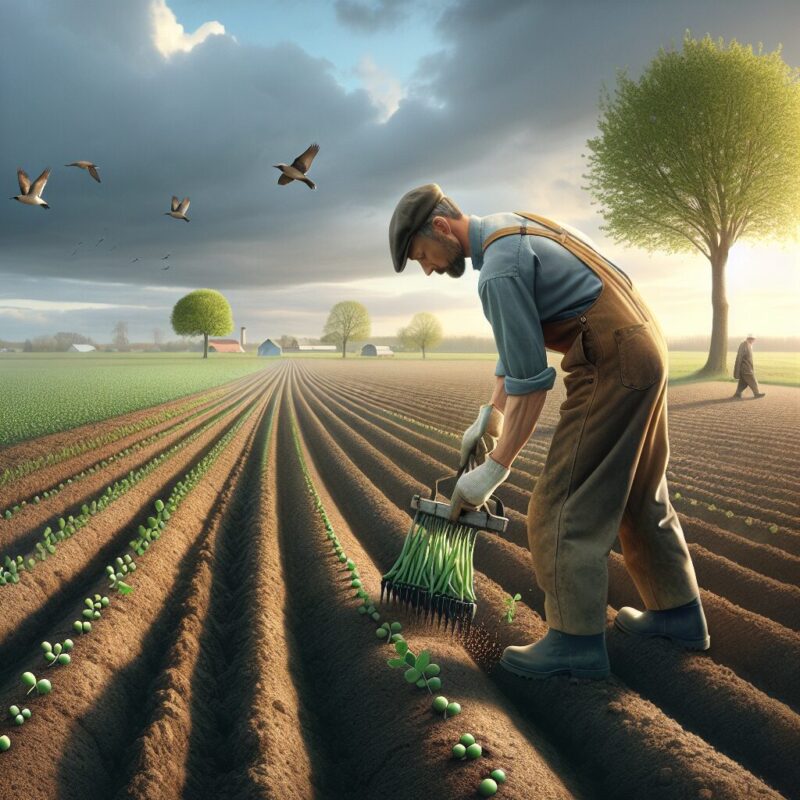When it comes to gardening in Kansas, timing is everything. One key vegetable that requires careful consideration in planting is peas. Known for their sweet and tender pods, peas are a popular choice among gardeners in the region. In fact, Kansas offers a suitable climate for growing peas due to its moderate temperatures and well-drained soils. Understanding the optimal time to plant peas can help maximize their growth and productivity, ensuring a bountiful harvest.
The timing of planting peas in Kansas is influenced by several factors. One important aspect to consider is the average last frost date in the area, which typically falls between late March and early April. Peas are a cool-season crop, thriving in temperatures between 40°F and 75°F. It’s important to sow the seeds early enough to allow them to mature before the scorching heat of summer arrives. Additionally, the soil temperature should be above 45°F for successful germination. By planting peas during the appropriate window, gardeners can take advantage of the full growing season, allowing the plants to flourish and produce flavorful pods.
As we dive deeper into the article, we will explore the ideal time frame for planting peas in Kansas and provide practical tips to ensure successful cultivation. We will discuss the different varieties of peas that thrive in the region, considering their unique features and adaptability. Additionally, we will touch upon the various methods of planting peas, including direct seeding and transplanting, and highlight the pros and cons of each approach. By the end of this article, you will have a comprehensive understanding of the best practices for planting peas in Kansas, empowering you to embark on a rewarding gardening experience.
Key Takeaways
1. The ideal time to plant peas in Kansas is in early spring, usually around mid-March to early April, when the soil temperature reaches around 45-50°F.
2. Peas can tolerate light frosts, but it is advisable to wait until the danger of hard freezes has passed before planting to avoid any potential damage to young seedlings.
3. It is recommended to choose pea varieties that are well-suited for Kansas’s climate, such as the ‘Wando’ and ‘Green Arrow’ varieties, known for their ability to handle hot weather.
4. Proper soil preparation is crucial for successful pea growth, including working organic matter into the soil and ensuring it is well-drained and slightly acidic, with a pH between 5.8 and 7.0.
5. Regular watering, mulching, and providing support structures like trellises or stakes are important for maintaining healthy pea plants and increasing yields in Kansas’s often hot and dry conditions.
When Is the Best Time to Plant Peas in Kansas? SEO Optimized Article Title Question
Pea Varieties Suitable for Kansas
When it comes to planting peas in Kansas, it is essential to select the right pea variety that thrives in the region’s climate and soil conditions. Some suitable options for Kansas include Sugar Snap peas, Green Arrow peas, and Little Marvel peas. These varieties have proven to be resilient and successful in Kansas gardens.
Determining the Frost-Free Date
Knowing the frost-free date in Kansas is crucial for determining the optimal time to plant peas. The last frost can vary across different regions in the state. Generally, it occurs around mid-April in southern Kansas and early May in northern areas. Before planting peas, ensure that the soil temperature has reached at least 45°F (7°C) to promote healthy germination.
Early Spring Planting
For early spring planting, it is recommended to sow peas in Kansas as soon as the soil is workable, typically in late March or early April. It is crucial to keep an eye on weather forecasts to avoid unexpected drops in temperature that can harm young pea plants. Providing adequate protection, such as row covers or cloches, can help safeguard the plants during cold snaps.
Successive Plantings for Extended Harvest
If you desire an extended harvest period, consider making successive plantings of peas in Kansas. This involves staggered sowings throughout the spring season to ensure a continuous supply of fresh peas. Start the first planting in early spring and continue every two to three weeks until late spring. This practice helps maximize the pea yield and extends the harvest period.
Exposure to Sun and Soil Conditions
Peas thrive in full sun, so it is important to locate your pea patch in an area that receives at least 6-8 hours of direct sunlight daily. Additionally, ensure that the soil is well-draining, fertile, and rich in organic matter. Before planting, incorporate compost or well-rotted manure into the soil to enhance its fertility and moisture retention capabilities.
Maintaining Moisture and Providing Support
Peas require consistent soil moisture for optimal growth and yield. Regular watering is necessary, especially during dry spells. Applying a layer of organic mulch around the base of the plants helps to retain moisture and suppress weed growth. Additionally, providing support for climbing varieties is essential. Install trellises, stakes, or pea fences to allow the plants to climb and prevent damage to the delicate vines.
Protecting Against Pests and Diseases
Like any garden crop, peas are susceptible to certain pests and diseases. Watch out for common invaders such as aphids, pea weevils, and powdery mildew. Inspect your plants regularly, and if you notice any signs of infestation or disease, take appropriate measures for control or seek advice from your local extension office. Applying organic pest control methods and practicing crop rotation can help prevent any potential issues.
Harvesting Peas at the Right Time
The best time to harvest peas in Kansas is when the pods are plump, but the peas inside are not overly mature. Pick the pods regularly, as this encourages further pod production. Harvesting at the right time ensures optimal tenderness and flavor. If left on the plant for too long, peas can become starchy and lose their sweet taste.
Numbered Guides or Tips on When to Plant Peas in Kansas
- What are some recommended pea varieties for Kansas?
- How do I determine the frost-free date in my area?
- When should I plant peas for an early spring harvest?
- How can I extend the pea harvest period through successive plantings?
- What are the ideal sun and soil conditions for growing peas in Kansas?
- What are some techniques to ensure proper moisture and support for pea plants?
- How can I protect my pea plants against pests and diseases?
- When is the right time to harvest peas in Kansas?
Frequently Asked Questions
1. When should I plant peas in Kansas?
The best time to plant peas in Kansas is in early spring, as soon as the soil can be worked. Typically, this falls between late March and mid-April. Peas prefer cool weather and can tolerate light frosts, making them an ideal crop for Kansas spring planting.
2. Can I plant peas indoors and then transplant them outside?
Peas are typically not recommended for indoor seed starting and transplanting. They have delicate roots that don’t transplant well, and they prefer direct sowing into the ground. It’s best to sow pea seeds directly into the garden or containers outdoors.
3. How deep should I plant pea seeds?
Pea seeds should be planted about 1 to 2 inches deep. If the soil is heavy or clay-like, planting them slightly shallower will be fine. Ensure that the soil is well-drained to avoid waterlogging, which can cause rotting of the seeds.
4. Can I plant peas in containers or pots?
Absolutely! Peas can be successfully grown in containers or pots as long as they have enough space to establish their root system. Use a container that is at least 12 inches deep and wide to ensure adequate room for growth. Make sure the container has good drainage to prevent waterlogging.
5. Do peas require any special soil conditions?
Peas prefer well-drained soil that is rich in organic matter. Improving the soil by adding compost or well-rotted manure before planting will provide the necessary nutrients for healthy pea growth. Peas also perform best in slightly acidic to neutral soil with a pH level of 6.0 to 7.0.
6. How often should I water my pea plants?
Peas require regular watering, especially during dry spells. Keep the soil consistently moist, but avoid overwatering, as this can lead to diseases and rot. Water deeply at the base of the plants, ensuring that the moisture reaches the roots.
7. Should I provide any support for my pea plants?
Most pea varieties benefit from support as they grow. Using trellises, stakes, or a pea fence will help the plants to climb and prevent them from sprawling on the ground. It also makes harvesting easier and keeps the peas cleaner.
8. How long does it take for pea plants to mature?
The time from planting to harvest for most pea varieties is around 60 to 70 days. However, this can vary depending on the specific cultivar and growing conditions. Keep an eye on the plants, and begin harvesting when the peas have reached the desired size and are still tender.
9. Are there any common pests or diseases that affect pea plants in Kansas?
Peas can be susceptible to pests like aphids, pea weevils, and powdery mildew. To prevent these issues, regularly inspect your plants and take prompt action if you notice any signs of infestation or disease. Proper spacing, good air circulation, and practicing crop rotation can also help prevent problems.
10. Can I plant peas for a fall harvest in Kansas?
Generally, peas are a cool-season crop and are not suitable for a fall harvest in Kansas. They thrive in the cooler temperatures of spring and early summer. However, if you have a mild fall season, you can attempt to plant a late-maturing variety and provide some frost protection to extend the growing season.
Final Thoughts
Planting peas in Kansas is an exciting endeavor that can yield a bountiful harvest. By following the recommended planting times and providing optimal growing conditions, you can enjoy fresh and delicious peas from your own garden. Remember to consider the specific requirements of pea plants, such as well-drained soil, regular watering, and appropriate support. Monitoring for pests and diseases is also crucial to ensure the health of your pea plants. Although fall planting may not be suitable for most pea varieties in Kansas, exploring different cultivars and experimenting with frost protection techniques can expand your options. So, don’t hesitate to start planting peas in Kansas and experience the joy of homegrown produce!

